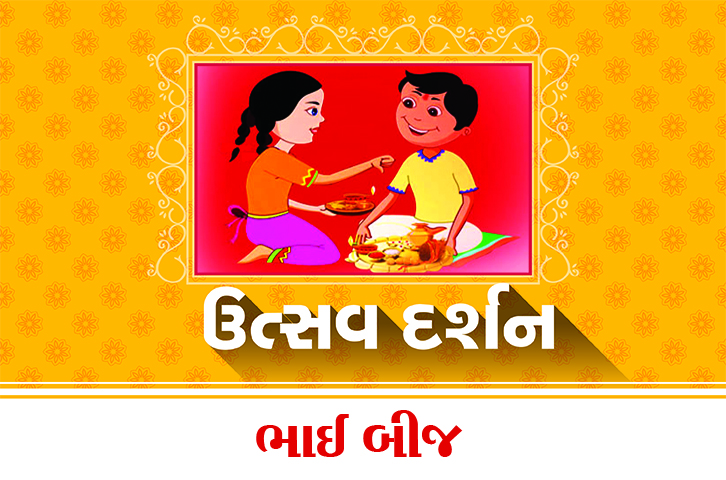Bhai Dooj – (ભાઈ બીજ)

ગુજરાતી
ભાઈબીજનું બીજું નામ ‘યમદ્વિતીયા’ છે. જૂના વર્ષના રાગદ્વેષોને ભૂલી નવા વર્ષમાં પ્રવેશની સાથે જ ભાઈ-બહેનના નિર્વ્યાજ પ્રેમની અભિવ્યક્તિ થાય છે. આ દિવસે યમુનાજીએ પોતાને ઘેર સ્વબંધુ યમરાજને નિમંત્રણ આપી પૂજા કરી પ્રથમ જમાડેલા ત્યારે પ્રસન્ન થયેલા યમરાજે બહેનને વરદાન માગવા કહ્યું. ત્યારે યમુનાજીએ માગ્યું : “હે ભાઈ ! તમારે દર વર્ષે આ દિવસે મારે ઘેર જમવા આવવું તેમજ આ દિવસે જે ભ્રાતા-પુરુષ પોતાની બહેનને ત્યાં ભોજન કરે તેને તમારે યથેષ્ટ સુખ આપવું.”
યા તુ ભોજ્યતે નારી ભ્રાતરં યુગ્મકે તીથૌ |
અર્ચયેચ્ચાપિ તાંબુલૈ ર્ન સા વૈધવ્યમાપ્નુયાત્ ||
જે નારી ભાઈબીજના દિવસે ભાઈને જમાડે – તાંબુલાદિક આપી પ્રસન્ન કરે તે વિધવા થતી નથી. ભાઈ-બહેનના પ્રેમનું પ્રતિક એટલે ભાઈબીજનો દિવસ. જો આ દિવસે ભાઈ બહેનને કોઈ કારણોસર ન મળી શકે તો ભાવભીની બહેન તે બીજના ચંદ્રને પોતાનો ભાઈ ગણી પૂજા કરે છે. તેથી બહેન ચંદ્રને ભાઈ ગણે છે અને તેના બાળકો ચંદ્રને ‘ચાંદામામા’ કહી પ્રેમથી હાંક મારે છે.
આ બીજના ચંદ્ર દર્શન પછી જ ઈસ્લામ લોકો રોજાના પારણા કરે છે, વેપારીઓ ચંદ્ર દર્શન પરથી બજારની તેજી-મંદીનું અનુમાન કરે છે. આમ, બીજના ચંદ્રનું આર્ય સંસ્કૃતિમાં ઘણું જ મહત્ત્વ છે. તેથી જ કદાચ પરબ્રહ્મ પુરુષોત્તમ ભગવાન શ્રી સ્વામિનારાયણે પોતાના ડાબા ચરણના તળે ચિહ્નરૂપે નિવાસ આપ્યો છે. અને મહાદેવ શિવજીએ પોતાના મસ્તક ઉપર બીજના ચંદ્રમાને ઘરેણા રૂપે ધારણ કરેલ છે. શ્રીજીમહારાજ વડતાલ પ્રકરણના ૧૨મા વચનામૃતમાં બીજના ચંદ્રનું દૃષ્ટાંત આપતા કહે છે : “ભગવાનના સ્વરૂપનો જેને સત્સમાગમે કરીને દૃઢ નિશ્ચય થાય છે તેનો જીવ બીજના ચંદ્રમાની પેઠે દિવસે દિવસે વૃદ્ધિ પામે છે.”
માટે આપણે પણ આ દિવસે એવો સંકલ્પ કરીએ કે, પંચવર્તમાન યુક્ત સાચા સંતોનો સમાગમ કરીને ભગવાનનો દૃઢ નિશ્ચય કરીએ. જેથી આપણે આ સત્સંગમાં બીજના ચંદ્રની પેઠે દિવસે દિવસે વૃદ્ધિ પામીએ. આ દિવસની આપણા સંપ્રદાયમાં એક વિશેષતા એ છે કે, આ દિવસે સુરતમાં શ્રીજીમહારાજે સ્વહસ્તે અરદેશરજી કોટવાળને આપેલ પાઘના દર્શન કરાવવામાં આવે છે. આમ, આ દિવસ ઘણો જ પવિત્ર ગણવામાં આવે છે.
English
Bhai Dooj, is a Hindu festival celebrated in India and Nepal. This is celebrated during the Diwali or Tihar festival, which is the most popular festival in India and Nepal. This festival is celebrated in the month of Kartik, according to the Hindu calendar. The rituals followed and celebrations of this day are similar to that of other popular celebration named, ‘Raksha Bandhan’. On this special occasion, brother gift their sisters with many gifts and in return sisters feed their brothers sweets.rnrnHindu MythologyrnrnThis day is celebrated in remembrance of the ancient myth. According to Hindu mythology, Lord Krishna defeats Narakasura on Diwali and visits her sister Subhadara. And during his visit, Subhadra welcomed her brother with sweets and flowers. Also, she applied ‘Tilak’, on his forehead as a sign of victory. And this is said to be the beginning of this ritual.rnrnOn this day, sisters invite their brothers for a special meal, which includes their favourite sweets and dishes. This ritual differs from place to place. This ritual symbolizes duty of brother to protect their sisters and sisters pray for their brothers health and long life. During this special occasion, sisters perform Aarti for their brothers and apply Tilak on their forehead. In return, brothers bless their sisters and favour them with gifts and sweets. In order to celebrate this ritual, it is important that both brother and sister should be above five years of age.rnrnEven though, this ritual is known by different names across India and Nepal, the motive of this ritual remains the same.
